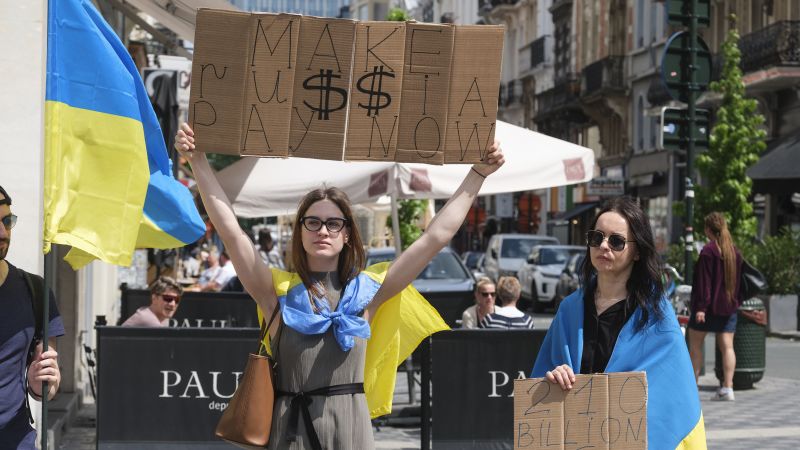Money generated by Russian financial assets frozen in Europe will soon start flowing to Ukraine, giving Kyiv a boost as it struggles to counter an advance by Moscow’s troops. Now, the West is trying to turn that trickle of cash into a flood.
Finance officials from the G7 economies met in Stresa, Italy to discuss new ways of using the proceeds from some €260 billion ($282 billion) of Russia’s foreign currency reserves that were frozen by Western countries after the full-scale invasion of Ukraine in 2022.
“Progress has been made … as far as the main issues are concerned,” Italian Economy Minister Giancarlo Giorgetti said Saturday during a press conference after the meeting, adding that there are some legal technical issues that still have to be resolved.
There is “strong positioning in terms of a political stance by all the G7 countries,” Giorgetti said.
The G7 meeting comes just weeks after Russia mounted a surprise assault in Ukraine’s northern Kharkiv region. As Russia’s attacks intensify, Western leaders are coming under increasing pressure to deliver military aid to Kyiv’s stretched armed forces.
It is “vital and urgent that we collectively find a way forward to unlock the value of Russian sovereign assets immobilized in our jurisdictions for the benefit of Ukraine,” US Treasury Secretary Janet Yellen said during a speech Tuesday in Frankfurt, Germany.
The proposal that reportedly has the broadest backing among US and EU officials involves lending as much as $50 billion to Ukraine, using the future windfall profits from Russian assets held in the European Union as collateral.
The plan “would essentially bring forward that flow of interest proceeds from the assets… (through a loan) given to Ukraine,” Yellen told broadcaster Sky News in an interview this week. “Ukraine has substantial needs, and being able to marshal significant resources to help Ukraine is important,” she said.
G7 finance ministers hope to agree on a way forward that can be signed off when President Joe Biden and other leaders meet for a summit in Italy next month.
The plan stops short of seizing the assets outright. The EU is worried that such a move would discourage other countries from keeping their assets in the bloc. Most of the frozen Russian money is held in Europe, and the euro is the world’s second-most important currency after the US dollar.
The proposal “is a halfway house to full seizure,” Lee Buccheit, a veteran sovereign debt expert and honorary professor at the University of Edinburgh Law School, told CNN.
Around two-thirds of Russia’s immobilized assets, or some €210 billion ($228 billion), sits in the EU, mostly at Euroclear, a Belgium-based financial institution that keeps assets safe for banks, exchanges and investors.
Following months of discussions, the EU formally adopted an agreement Tuesday that taps the windfall profits Euroclear makes by reinvesting the cash generated by those assets — such as coupon payments on bonds. Western sanctions mean coupon payments and maturing assets cannot be sent to Russia.
Under the EU agreement, between €2.5 and €3 billion ($2.7-3.3 billion) of these profits will be sent annually to Kyiv. The first payment will be made in July, with 90% earmarked for arms and military equipment.
The split of funds will be reviewed each year starting in January 2025, with the option to shift spending toward rebuilding Ukraine’s war-torn economy as its needs change.
“The EU has chosen a way forward that is legally sound, and flexible so that support can adjust to Ukraine’s most pressing needs,” European Commissioner for Trade Valdis Dombrovskis said in a statement Tuesday.
Unlike the drip feed of funding agreed by the EU, the proposal under discussion by the G7 could deliver a much bigger lump sum, immediately.
Reuters reported Yellen as saying Thursday that a figure of $50 billion had been discussed by G7 ministers but there was no agreement yet on how big the collateralized loan should be.
Apart from seizing the stash of assets, or lending Kyiv money backed by the interest they earn, there’s a third option the West might consider — a so-called reparations loan.
Under this approach, Ukraine would borrow money from a syndicate of allies, including G7 members, and pledge as collateral its claim for reparations — or compensation — against Russia. This would give Kyiv access to a much larger amount of money than using future or current windfall profits from Russian assets.
“Ukraine has a claim against Russia for reparations — legally, that is indubitable — and it would in effect be monetizing a portion of that claim by pledging it to secure this loan from the G7,” Buchheit, the debt expert, said.
If Russia failed to pay reparations, then the G7 would be in a position to draw on the pool of frozen assets to recover the value of its loan to Ukraine, he added.
This mechanism also ensures that Russia foots part of the colossal bill for rebuilding Ukraine, which the World Bank has put at $486 billion over the next decade.
“Short of a regime change in Russia, Putin is never going to pay reparations,” said Buccheit. “This $300 billion is probably the only contribution Russia will ever make for paying reparations for what it has done to Ukraine.”
Read the full article here




